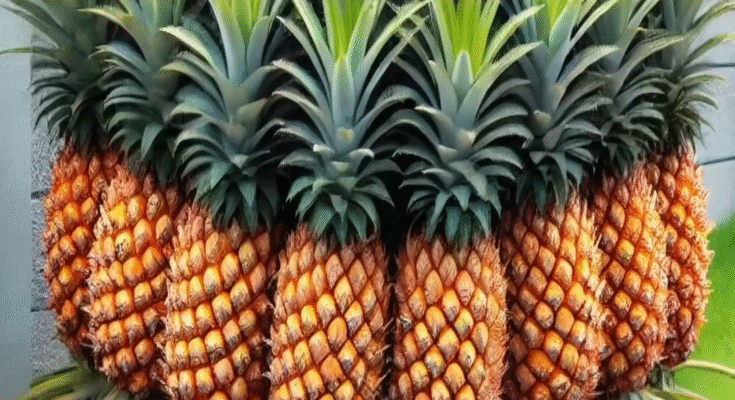Enjoy More Pineapple Harvest: Pineapple Planting Method
If you dream of walking through your garden and picking fresh, sweet pineapples, you are not alone. Pineapple (Ananas comosus) is one of the easiest tropical fruits to grow at home with minimal effort if you know the right planting techniques. Whether you have a small backyard or a few pots on a balcony, the right pineapple planting method can help you enjoy a bigger harvest and juicier fruits.
Pineapples are unique because they grow from the ground up through a rosette of spiky leaves, producing only one fruit per plant at a time. However, with the right care and method, each plant can produce suckers and slips that can be replanted to multiply your harvest year after year.
Let’s break down the best pineapple planting method step by step so you can enjoy more pineapples from your own garden.
1. Choose Healthy Planting Material
The easiest way to start growing pineapples is by using the crown of a fresh pineapple. Next time you buy a ripe pineapple, do not throw away the leafy top! Twist it off gently and remove the lower leaves to reveal about an inch of stem. Let it dry in the shade for one or two days to reduce the risk of rotting.
You can also grow pineapples from suckers or slips. Suckers grow between the leaves of the mature plant while slips grow below the fruit. Both can be removed and replanted to grow new pineapple plants faster than crowns.
2. Prepare the Soil Well
Pineapples prefer well-drained, slightly acidic soil. They do not tolerate waterlogged conditions, so choose a spot with good drainage or use raised beds or large pots. Mix sandy loam soil with compost or well-rotted manure to provide nutrients. If planting in containers, use a pot at least 12 inches deep with drainage holes.
Add organic matter to improve fertility and aeration. A little handful of slow-release fertilizer or balanced organic compost will give your young pineapple a healthy start.
3. Planting the Crown, Sucker, or Slip
Dig a small hole about 3–4 inches deep. Place the prepared crown, sucker, or slip into the hole and firm the soil around it. Make sure the base is secure but do not bury the leaves. Water the plant lightly after planting to help the roots settle.
If you live in a very hot or dry area, provide a little shade for the first few weeks. Pineapples love sunshine but young plants can get stressed under harsh sun before they establish roots.
4. Proper Spacing
If planting multiple pineapples, space each plant about 2–3 feet apart in rows that are 3–5 feet apart. Proper spacing ensures good air circulation, which prevents diseases and allows each plant enough space to grow a healthy fruit.
In pots, limit one plant per pot for the best result. Pineapples do not like to compete for nutrients and water.
5. Watering and Mulching
Pineapples are drought-tolerant but they still need water to thrive and fruit well. Water deeply once a week in dry periods but avoid overwatering. The soil should be moist but not soggy. Too much water causes root rot.
Mulch around the base with straw, dry leaves, or grass clippings to keep the soil moist, suppress weeds, and maintain soil temperature.
6. Feeding for Bigger Fruits
Feed your pineapple plants with a balanced organic fertilizer every two to three months. Pineapples love nitrogen in the early stages for leaf growth and potassium to boost fruit size and sweetness. You can also use compost tea or diluted fish emulsion.
Sprinkle a handful of compost around the base and gently work it into the topsoil. Avoid direct contact with the plant’s base to prevent rot.
7. Control Pests and Diseases Naturally
Pineapples have few pests but keep an eye out for mealybugs and scale insects. Use neem oil or soapy water to wash them off. Good air circulation and clean soil help prevent fungal diseases.
Weeds can compete with your pineapples for nutrients, so keep the area weed-free, especially in the early growth stage.
8. Induce Flowering for Faster Harvest
In some cases, pineapples take 18–24 months to flower naturally. If your plants are healthy and mature but not flowering, you can induce flowering by placing an apple inside the center of the plant and covering it with a plastic bag for a few days. Apples release ethylene gas, which encourages flowering.
9. Harvesting at the Right Time
When the pineapple fruit turns golden yellow from the base upwards, it is ready to harvest. The fruit will not continue to ripen once picked, so wait until it is fully colored and fragrant. Twist the fruit gently to remove it from the plant.
After harvest, the same plant may produce more suckers and slips, which you can plant again to enjoy more pineapples for years.
Final Thoughts
Growing pineapples at home is a fun and rewarding experience. By following this simple pineapple planting method—choosing healthy crowns or slips, preparing the soil well, giving enough space, watering correctly, feeding regularly, and managing pests naturally—you can enjoy more pineapples from your own garden with minimal cost.
Start today, and in about 18 months, you could be slicing into your own sweet, homegrown pineapple. Share your surplus with family and neighbors or grow a pineapple patch that keeps producing year after year. Once you taste your own harvest, you will never look at store-bought pineapples the same way again!



